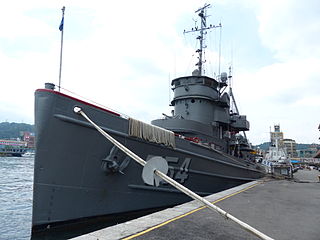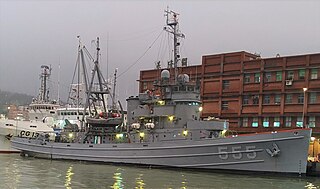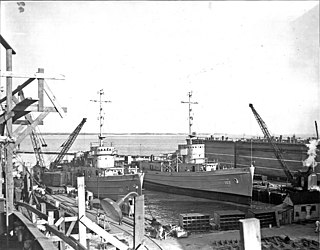
USS Achomawi (AT-148/ATF-148) was an Abnaki-class fleet ocean tugs in the service of the United States Navy, and was named for the Achomawi tribe of Native Americans.

USS Mattole (AO‑17) was a Kaweah-class fleet replenishment oiler in the United States Navy.
USS Arikara (AT-98) was an Abnaki-class of fleet ocean tug. It was named after the Arikara, a loose confederacy of sub-tribes of American Indians related to the Pawnee. The Arikara inhabited villages in the Missouri River valley.

USS Alexander J. Luke (DE/DER-577), a Buckley-class destroyer escort of the United States Navy, was named in honor of Sergeant Alexander J. Luke (1916–1942), who was killed in action during the attack on Tulagi on 6 August 1942. He was posthumously awarded the Silver Star.

USS Atakapa (ATF-149) was an Achomawi class of fleet ocean tug. It was named after the Atakapa Native American tribe that once inhabited territory which is now southwestern Louisiana and southeastern Texas.

USS Quapaw (ATF–110/AT-110) was a Abnaki-class fleet ocean tug in the United States Navy. She was named after the Quapaw.
The second USS Bluebird (ASR-19) was a Penguin-class submarine rescue ship in the United States Navy.

USS Sellstrom (DE-255) was an Edsall-class destroyer escort built for the U.S. Navy during World War II. She served in the Atlantic Ocean, the Pacific Ocean and provided destroyer escort protection against submarine and air attack for Navy vessels and convoys.

USS Narragansett (AT-88) was a Navajo-class fleet tug constructed for the United States Navy during World War II. Her purpose was to aid ships, usually by towing, on the high seas or in combat or post-combat areas, plus "other duties as assigned." She served in the Atlantic Ocean and, at war’s end, returned home with three battle stars to her credit.

USS Seneca (AT-91) was a Navajo-class fleet tug constructed for the United States Navy during World War II. Her purpose was to aid ships, usually by towing, on the high seas or in combat or post-combat areas, plus "other duties as assigned." She served in the Atlantic Ocean performing various tasks.
USS Chippewa (AT-69) was a Navajo-class fleet tug constructed for the United States Navy during World War II. Her purpose was to aid ships, usually by towing, on the high seas or in combat or post-combat areas, plus "other duties as assigned." She served in the Atlantic Ocean.

USS Chimariko (ATF-154) was an Abnaki class Fleet Ocean Tug of the United States Navy and the first to be named Chimariko after the Native American tribe in California.

The third USS Kiowa (AT-72), later ATF-72, was a fleet tug, later fleet ocean tug, that served in the United States Navy from 1943 to 1972.
USS Cherokee (AT-66) was a US Navy fleet tug of the Navajo class, later renamed the Cherokee class. She was launched on 10 November 1939 by Bethlehem Shipbuilding Corp., Staten Island, New York and sponsored by Miss E. Mark; and commissioned 26 April 1940, Lieutenant Commander P. L. F. Weaver in command. Cherokee served during World War II in the North African campaign. She was redesignated ATF-66 on 15 May 1944.

USS Avoyel (ATF-150) was an Navajo-class fleet tug built for the United States Navy during World War II. She was the only U.S. Naval vessel to bear the name.

USS Choctaw (AT-70) was a Navajo-class fleet tug constructed for the United States Navy during World War II. Her purpose was to aid ships, usually by towing, on the high seas or in combat or post-combat areas, plus "other duties as assigned." She served in Bermuda during the end of World War II where she was primarily responsible to aiding in the assembly of convoys and ships taking part in training. On 15 May 1944, she was redesignated ATF-70. She continued to serve for 3 more years before being decommissioned on 11 March 1947.

USS Moctobi (ATF-105) was an Abnaki-class of fleet ocean tug. She served in World War II, Vietnam, and Korea, the last two of which she received battle stars. She was scrapped in 2012.

USS Hidatsa (ATF-102) was Abnaki-class tugboat during the World War II. The ship was later sold to Colombia as ARC Rodrigo de Bastidas (RM-74). Her namesake is an Indian group of the Sioux Tribe of North Dakota, now living on the Fort Berthold Reservation.

USS Jicarilla (ATF-104) was Abnaki-class tugboat during the World War II. The ship was later sold to Colombia as ARC Sebastián De Belalcázar (RM-73). Her namesake is a group of the Apache tribe found in the southwestern United States.

USS Mosopelea (ATF-158) was Abnaki-class tugboat during the World War II and Cold War. Her namesake is an Indian tribe which inhabited the area near the junction of the Ohio and Mississippi Rivers.
















